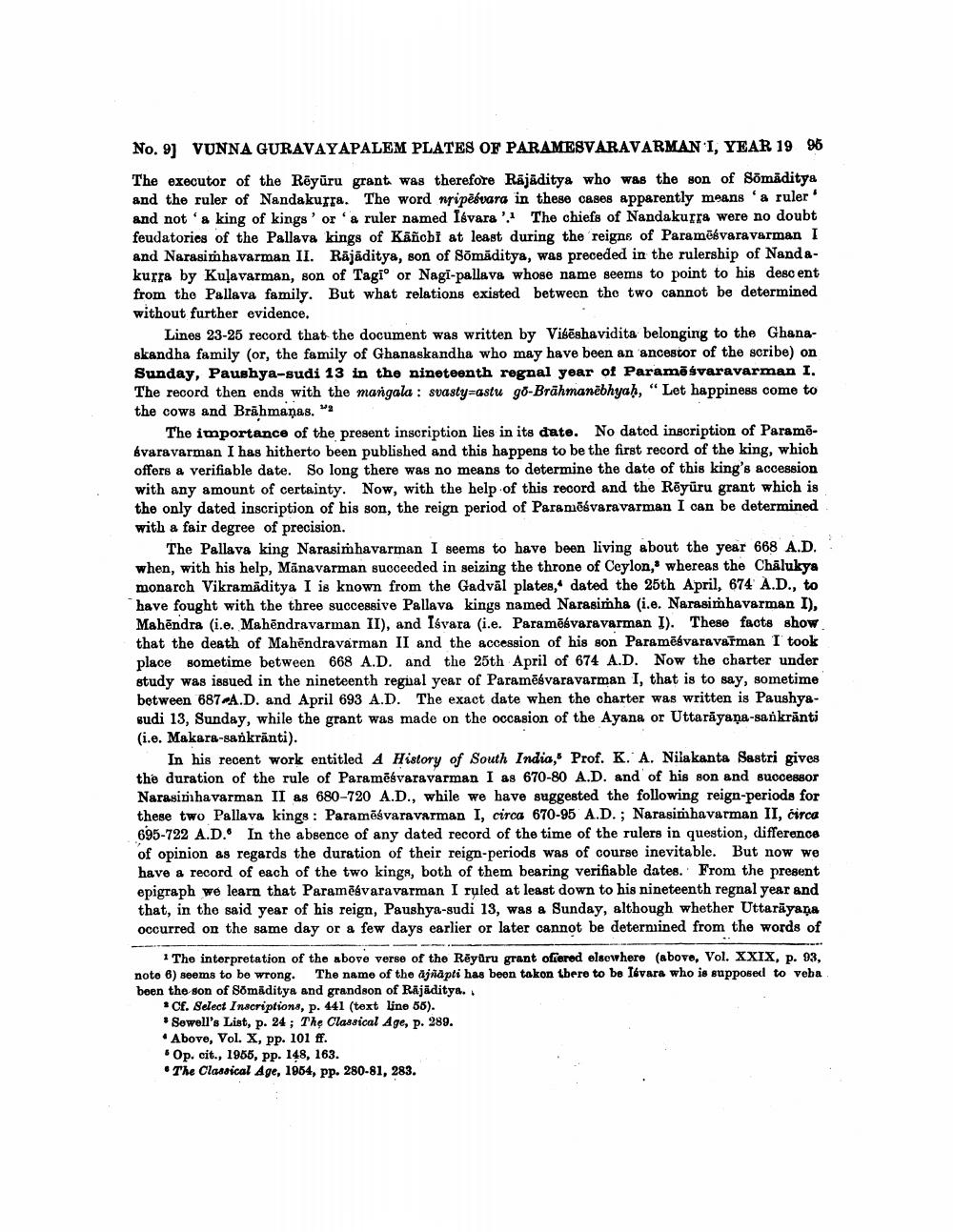________________
No. 9] VUNNA GURAVAYAPALEM PLATES OF PARAMESVARAVARMANI, YEAR 19 95
The executor of the Rēyuru grant was therefore Räjäditya who was the son of Somaditya and the ruler of Nandakurra. The word npipēšvara in these cases apparently means a ruler and not a king of kings' or 'a ruler named Isvara '.1 The chiefs of Nandakurra were no doubt feudatories of the Pallava kings of Kāñcbi at least during the reigns of Paramēbvaravarman I and Narasimhavarman II. Rājāditya, son of Somāditya, was preceded in the rulership of Nandakurra by Kuļavarman, son of Tagio or Nagi-pallava whose name seems to point to his descent
from the Pallava family. But what relations existed between the two cannot be determined without further evidence.
Lines 23-25 record that the document was written by Vibëshavidita belonging to the Ghanaskandha family (or, the family of Ghanaskandha who may have been an ancestor of the scribe) on Sunday, Paushya-sudi 13 in the nineteenth regnal year of Paramāśvaravarman I. The record then ends with the mangala : svasty=astu go-Brāhmanēbhyah, "Let happiness come to the cows and Brāhmanas. 2
The importance of the present inscription lies in its date. No dated inscription of Paramēsvaravarman I has hitherto been published and this happens to be the first record of the king, which offers a verifiable date. So long there was no means to determine the date of this king's accession with any amount of certainty. Now, with the help of this record and the Rēyuru grant which is the only dated inscription of his son, the reign period of Paramëśvaravarman I can be determined with a fair degree of precision.
The Pallava king Narasimhavarman I seems to have been living about the year 668 A.D. when, with his help, Mānavarman succeeded in seizing the throne of Ceylon,' whereas the Chalukya monarch Vikramaditya I is known from the Gadväl plates, dated the 25th April, 674 A.D., to have fought with the three successive Pallava kings named Narasimha (i.e. Narasimhavarman I), Mahēndra (i.e. Mahēndravarman II), and Isvara (i.e. Paramēbvaravarman I). These facts show that the death of Mahendravarman II and the accession of his son Para mēsvaravarman I took place sometime between 668 A.D. and the 25th April of 674 A.D. Now the charter under study was issued in the nineteenth regial year of Paramēsvaravarman I, that is to say, sometime between 687 A.D. and April 693 A.D. The exact date when the charter was written is Paushyasudi 13, Sunday, while the grant was made on the occasion of the Ayana or Uttarayana-sankranti (i.e. Makara-sankranti).
In his recent work entitled A History of South India, Prof. K. A. Nilakanta Sastri gives the duration of the rule of Paramēśvaravarman I as 670-80 A.D. and of his son and successor Narasimhavarman II as 680-720 A.D., while we have suggested the following reign-periods for these two Pallava kings : Paramēsvaravarman I, circa 670-95 A.D.; Narasimhavarman II, circa 695-722 A.D. In the absence of any dated record of the time of the rulers in question, difference of opinion as regards the duration of their reign-periods was of course inevitable. But now we have a record of each of the two kings, both of them bearing verifiable dates. From the present epigraph we learn that Paramēsvaravarman I ruled at least down to his nineteenth regnal year and that, in the said year of his reign, Paushya-sudi 13, was a Sunday, although whether Uttarayana occurred on the same day or a few days earlier or later cannot be deterniined from the words of
1 The interpretation of the above verse of the Rēyuru grant ofierod elsowhere (above, Vol. XXIX, p. 93, noto 6) seems to be wrong. The name of the ajriāpti has been takon there to be Isvara who is supposed to veba been the son of Somāditya and grandson of Rājāditya..
* Cf. Select Inscriptions, p. 441 (text line 55). * Sewell's List, p. 24; The Classical Age, p. 289. • Above, Vol. X, pp. 101 ff. • Op. cit., 1955, pp. 148, 163. • The Classical Age, 1954, pp. 280-81, 283.




